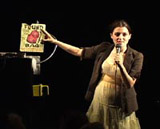
Halfway through The Foundry Theater's Major Bang or: How I Learned to Stop Worrying and Love the Dirty Bomb, the two accomplished performers (who had already played numerous roles in the magic-trick-laden exploration of fatherhood, the politics of boy scouts, and the war on terror) stopped the show.
Maggie Hoffman plugged in a vacuum and loudly collected the shattered remains of a light bulb that had exploded just moments before in Steve Cuiffo's hand, while Cuiffo gave the audience a "Lec-Dem for Critics" entitled "How I Learned to Stop Worrying and Love This Play," which encouraged the audience to relax and suspend their disbelief, noting that this play was at a particular disadvantage because its central topic--bombing--doesn't fit on stage. Cuiffo suggested during this pause in the action that theater is by nature "reductive," and that other epic events, such as war, can be reduced to the size of the performance space because emblematic parts can represent the whole, i.e. The French Revolution can be described by two men, each representing a side of the conflict such as Javert and Val Jean in Les Miserables. Terrorism on the other hand, Cuiffo continued, particularly bombing, defies reduction because the victims are random, linked only by time and place, not cause, and cannot therefore be adequately depicted by representatives. It is interesting that Major Bang succeeded most when dissecting itself and highlighting its own shortcomings in the depiction of its subject. The admission that the troubling questions surrounding terrorism which sparked the plays creation had not been (and perhaps could not be) adequately addressed in a theatrical setting made the theatrical setting that much more effective at addressing those same troubling issues.
By revealing its limitations, Major Bang encouraged its audience to turn our focus away from the execution of the trick and open our minds to the effect of the magic. At the end of the play, Cuiffo and Hoffman tented themselves in a protective layer of plastic sheeting to wait out impending disaster. They floated slowly toward the ceiling and disappeared, leaving the plastic sheeting to float empty to the stage floor as an explosion blasted the theater. The sound was jarring, complex and long. It spurred an initial collective jump from the audience followed by a distressing amount of time to contemplate the potential reality of that noise. Yet The Foundry Theater did not leave us in the despair of possible annihilation. Instead, as the car alarms died down, a video appeared of a woman, walking with the backpack that had represented the omnipresent bomb-threat throughout the play. The woman was visible in color and the others in the crowd were black-and-white. For a moment, it seemed that the scene would explode in another depiction of the irreducible, but the explosion didn't come. Instead, the woman returned the backpack to another woman who had lost it, and gradually color enveloped the on-screen crowd while a voiceover extolled a hope for "enlightenment's victory."
St. Ann's Warehouse, 38 Water Street DUMBO Brooklyn, NY
Ms. Maxfield is the co-founder and artistic director of Red Metal Mailbox, a New-York based company dedicated to creating investigative works of theater by linking original text with a highly physical aesthetic. In addition to directing and performing with RMM, Sarah works a day job in arts administration and occasionally writes about performance.
